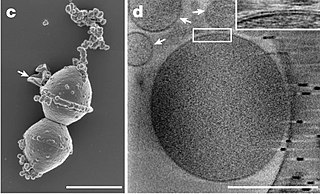Related Research Articles

Enterobacteriaceae is a large family of Gram-negative bacteria. It includes over 30 genera and more than 100 species. Its classification above the level of family is still a subject of debate, but one classification places it in the order Enterobacterales of the class Gammaproteobacteria in the phylum Pseudomonadota. In 2016, the description and members of this family were emended based on comparative genomic analyses by Adeolu et al.

Enterobacterales is an order of Gram-negative, non-spore forming, facultatively anaerobic, rod-shaped bacteria with the class Gammaproteobacteria. The type genus of this order is Enterobacter.

In prokaryote nomenclature, Candidatus is used to name prokaryotic phyla that are well characterized but yet-uncultured. Contemporary sequencing approaches, such as 16S ribosomal RNA sequencing or metagenomics, provide much information about the analyzed organisms and thus allow to identify and characterize individual species. However, the majority of prokaryotic species remain uncultivable and hence inaccessible for further characterization in in vitro study. The recent discoveries of a multitude of candidate taxa has led to candidate phyla radiation expanding the tree of life through the new insights in bacterial diversity.
"Candidatus Carsonella ruddii" is an obligate endosymbiotic Gammaproteobacterium with one of the smallest genomes of any characterised bacteria.
Devosia is a genus of Gram-negative soil bacteria. It is named after the Belgian microbiologist Paul De Vos. They are motile by flagella, the cells are rod-shaped.

Liberibacter is a genus of Gram-negative bacteria in the Rhizobiaceae family. Detection of the liberibacteria is based on PCR amplification of their 16S rRNA gene with specific primers. Members of the genus are plant pathogens mostly transmitted by psyllids. The genus was originally spelled Liberobacter.
"Candidatus Caballeronia calva" is a bacterium from the genus Caballeronia and the family Burkholderiaceae. "Candidatus Caballeronia calva" is an endosymbiont of Psychotria calva.
Sodalis is a genus of bacteria within the family Pectobacteriaceae. This genus contains several insect endosymbionts and also a free-living group. It is studied due to its potential use in the biological control of the tsetse fly. Sodalis is an important model for evolutionary biologists because of its nascent endosymbiosis with insects.
"Candidatus Caballeronia nigropunctata" is a Candidatus species of bacteria from the genus Caballeronia and the family Burkholderiaceae. "Candidatus Caballeronia nigropunctata" is an endosymbiont of the plant Psychotria nigropunctata.
"Candidatus Caballeronia verschuerenii" is a bacterium from the genus of Caballeronia and the family Burkholderiaceae.
Devosia albogilva is a Gram-negative, aerobic, rod-shaped non-spore-forming bacteria from the genus of Devosia with a single polar flagellum which was isolated from a hexachlorocyclohexane dump site in India.
Devosia chinhatensis is a Gram-negative, rod-shaped non-spore-forming motile bacteria from the genus of Devosia.
Devosia geojensis is a Gram-negative, aerobic, motile bacteria from the genus of Devosia with a single polar flagella which was isolated from diesel-contaminated soil in Geoje in the Republic of Korea.
Devosia insulae is a Gram-negative, non-spore-forming motile bacteria from the genus of Devosia with a single flagellum. It was first isolated from soil samples collected in Dokdo, in the Republic of Korea.
Devosia psychrophila is a psychrophilic, aerobic, Gram-negative, rod-shaped bacteria from the genus of Devosia which was isolated from the Pitztaler Jöchl glacier in the Oetztaler Alps in Tyrol in Austria.
Devosia subaequoris is a Gram-negative, oxidase- and catalase-positive, non-spore-forming, motile bacteria from the genus of Devosia which was isolated from a sediment sample from the Hwasun Beach in Jeju in the Republic of Korea.
Devosia submarina is a Gram-negative, aerobic, motile bacterium in the genus Devosia which was isolated from the Sea of Japan.
Devosia yakushimensis is a Gram-negative, obligately aerobic, motile bacteria from the genus of Devosia with a polar flagellum which was isolated from the plant Pueraria montana var. lobata in Japan.
"Candidatus Karelsulcia muelleri" is an aerobic, gram-negative, bacillus bacterium that is a part of the phylum Bacteroidota. "Ca. K. muelleri" is an obligate and mutualistic symbiotic microbe commonly found occupying specialized cell compartments of sap-feeding insects called bacteriocytes. A majority of the research done on "Ca. K. muelleri" has detailed its relationship with the host Homalodisca vitripennis. Other studies have documented the nature of its residency in other insects like the maize leafhopper (Cicadulina) or the spittlebug (Cercopoidea). "Ca. K. muelleri" is noted for its exceptionally minimal genome and it is currently identified as having the smallest known sequenced Bacteroidota genome at only 245 kilobases.

"Candidatus Azoamicus ciliaticola" is a candidate species of endosymbiotic bacteria belonging to the eub62A3 group of Gammaproteobacteria, characterized for its capacity to perform denitrification within its ciliate host in anaerobic water environments. It was isolated from Lake Zug in Switzerland and described in 2021.
References
- 1 2 UniProt
- ↑ "Straininfo of Candidatus Devosia euplotis". Archived from the original on 2014-12-18. Retrieved 2014-12-18.
- ↑ "Straininfo of Candidatus Devosia euplotis". Archived from the original on 2014-12-18. Retrieved 2014-12-18.
- ↑ Vannini, C. (2004). "Identification of the bacterial endosymbionts of the marine ciliate Euplotes magnicirratus (Ciliophora, Hypotrichia) and proposal of 'Candidatus Devosia euplotis'". International Journal of Systematic and Evolutionary Microbiology. 54 (4): 1151–6. doi: 10.1099/ijs.0.02759-0 . PMID 15280284.